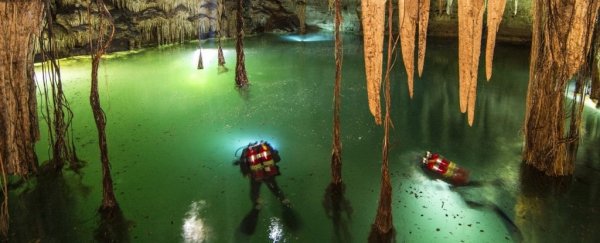The world's caves are easily forgotten. Missing from most maps and hidden from the surface, these underground kingdoms are often cloaked by darkness and shrouded in mystery.
They're natural labyrinths that only the most adventurous dare to navigate. Crafted over many thousands of years into a maze of lava, limestone or ice, finding a way in is often hard enough. Getting a story out is another matter.
It's the sort of thing that makes headlines around the world, and in 2018, we were fortunate enough to discover several incredible new caverns. But that wasn't where the cave news ended. Here are some of the most gripping narratives from underground from the past year.
1. The Sac Actun System
In January, after 10 months of intensive exploration, scientists in Mexico finally managed to locate what would turn out to be the world's largest flooded cave system.
This underwater wonderland, called the Sac Actun System, includes an astonishing 347 kilometres (216 miles) of subterranean caverns.
But even though much of the world's plumbing remains unexplored, we were not the first humans to have stumbled upon this particular wonder.
Within these waterlogged halls, the explorers found evidence from the first settlers of America, the Maya, as well as remnants of creatures that have gone long extinct, like giant sloths, bears and an elephant-like animal called a gomphothere.
"It's a tunnel of time that transports you to a place 10,000 to 12,000 years ago," underwater archaeologist Guillermo de Anda from Mexico's National Institute of Anthropology and History told the Mexican media at the time.
Just one month later and even more precious artefacts were added to the list, including human skeletons at least 9,000 years old - far earlier than our ancestors were thought to have arrived in eastern Mexico.
All in all, 198 archaeological sites were discovered, some 140 of which are Maya in origin, making this cave system the most important submerged archaeological site in the world.
2. La Cueva de los Verdes lava tube
That was just the beginning. A couple months later one of the world's largest volcanic cave complexes - the La Cueva de los Verdes lava tube in Spain - was mapped by researchers in the greatest detail ever, covering every corner and crevice of this volcanic wormhole.
The breathtaking scans and videos are a breakthrough in geological mapping, allowing us a glimpse into the subterranean passages that have remained elusive until now.
Join us on a trip through a volcanic wormhole! This 3D scan of the 8-km 'La Cueva de los Verdes' lava tube in Lanzarote, #Spain, was acquired during the @ESA_CAVES #Pangaea campaign.
— European Space Agency (@esa) March 13, 2018
Details: https://t.co/5csZlbzv4p pic.twitter.com/bVeZFCeyIP
3. The Thai soccer team
As brilliant and impressive as cave systems are, their complexity is also what makes them dangerous. The story about the Thai soccer team trapped in a cave by rising floodwaters was an 18-day ordeal that could have ended in tragedy if it wasn't for the quick and smart response from rescuers.
Not to mention the sheer bravery displayed by everyone involved. All 12 boys and their coach were successfully rescued after a harrowing four kilometre trip (2.5 miles); at times, during their rescue they were completely deprived of oxygen.
4. Blombos Cave etchings
When they aren't busy trying to kill us, caves can also be a canvas for our thoughts. A piece of cave art, discovered in 2011 in Cape Town's Blombos Cave, was this year revealed as the oldest known drawing in human history.
The cave-art is scratched with purpose, left by a 'crayon' of ochre shaved to a fine point. The significance of this tool is immense. It means that humans made pigment-based symbolic art 30,000 years earlier than we thought.
 (Craig Foster/istock)
(Craig Foster/istock)
5. China's Massive Sinkhole
The world's caves have a way of giving us the slip, even when they are right underfoot. But sometimes, when we least expect it, we are fortunate enough to catch them.
In September, an expedition to explore a giant sinkhole in China revealed something even more impressive. Nearby, explorers found a tremendous underground cavern containing corridors, halls, craters, collapsed rocks, stone pillars and cave pearls.
The size of the complex is so great - at no less than 6.7 million cubic metres (236 million cubic feet) - that geological experts have called it 'world class'.
6. The 'Sarlacc Pit'
In many ways, 2018 left the best for the last. Just last month, a huge, gaping cave was discovered in the remote Canadian wilderness - one that may have never been seen by human eyes before.
Named after the monstrous pit-dwelling beast in Star Wars, it certainly lives up to its reputation. Researchers are still not disclosing the location of this monstrosity, but judging by their descriptions, its a site to behold.
"My immediate reaction was that there can't be a cave there, it's impossible," geoscientist Catherine Hickson, who conducted an expedition to the site in September, told Global News.
"It is huge. It is enormous. When you first see it, you just gasp because it's just this huge hole in the ground."
